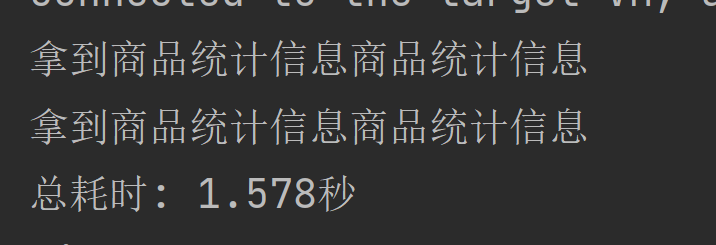一、写在开头
我们先给出同步和异步的概念
- 同步:同步编程指的是程序在执行某个任务时,会阻塞当前线程,直到任务完成。在这种模式下,后续的代码会等待任务完成之后再继续执行。
- 异步:异步编程指的是程序在执行某个任务时,不会阻塞当前线程,而是将任务交给其他线程去执行,当前线程可以继续执行其他操作。任务完成后,会通过回调、通知等方式处理结果。
二、使用异步编排的原因
问题举例
查询商品详情页的逻辑非常复杂,此时数据的获取涉及到多个RPC远程调用,那么必然需要花费更多的时间。假如商品详情页的查询。

- 由图,用户需要3.5s后才能看到商品详情页的内容。很显然是不能接受的。如果有多个线程同时完成这4步操作,也许只需要1.5s即可完成响应。
- 在这里需要注意的是,在将这四个任务异步化之后,需要注意的是这四个任务之间的联系,比如获取用户的基本信息这个任务,我们需要获取商品的分类信息执行完返回的结果传入才能执行,这时候,我们就必须保证这两个任务之间的排序问题,怎么解决呢?请看下面。
Future
Java在JDK1.5之后引入了JUC包,里面包含了一个接口:Future,这算是Java中实现异步编程的开山鼻祖, 然而,Future 的局限性在于它的功能相对简单,无法很好地处理复杂的异步任务链。Future 的局限性在这里给出,有兴趣的朋友可以具体去了解,这里不重点说Future。
- 阻塞获取结果:future.get() 方法是阻塞的,无法在不阻塞的情况下处理结果。
- 缺乏组合功能:无法轻松地组合多个异步任务,例如任务链、并行任务等。
- 异常处理复杂:异常处理不够简洁,需要手动捕获并处理异常。
CompletableFuture
随着 Java 版本的演进,CompletableFuture在 JDK 8 中引入,提供了更强大和灵活的异步编程支持。它不仅可以用来表示异步计算的结果,还提供了许多方便的方法来处理异步任务的执行和结果处理。以下是 CompletableFuture 的一些主要用途:
- 异步计算:
CompletableFuture可以表示一个异步计算的结果,允许在计算完成后继续执行其他操作。例如,CompletableFuture.supplyAsync可以异步执行一个任务并返回结果。 - 非阻塞操作:与传统的
Future需要使用get方法阻塞等待结果不同,CompletableFuture提供了非阻塞的方法,例如thenApply、thenAccept和thenRun,允许在计算完成后执行回调函数。 - 组合多个异步任务:
CompletableFuture提供了方法来组合多个异步任务,例如thenCombine、thenCompose和allOf等,允许对多个异步任务进行组合操作。 - 处理异常:
CompletableFuture提供了方法来处理异步计算中的异常,例如exceptionally和handle。 - 构建复杂的异步流:通过链式调用,
CompletableFuture允许构建复杂的异步流,简化异步编程模型,提高代码的可读性和可维护性。
三、CompletableFuture学习
下面我们在具体学习一下CompletableFuture的使用
1. runAsync 与 supplyAsync
- runAsync
:runAsync方法用于启动一个没有返回值的异步任务。该方法通常用于那些不需要返回结果的任务,例如记录日志、发送通知等。 - supplyAsync :
supplyAsync方法用于启动一个有返回值的异步任务。该方法通常用于需要返回结果的任务,例如计算结果、获取数据等。
public class Demo01 {
public static void main(String[] args) throws Exception {
supplyAsync();
System.out.println("main来了");
SleepUtils.sleep(3);
}
//发起一个异步请求
public static void runAsync() {
CompletableFuture.runAsync(new Runnable() {
@Override
public void run() {
System.out.println(Thread.currentThread().getName()+"你好runAsync");
SleepUtils.sleep(10);
}
});
}
//发起一个异步请求
public static void supplyAsync() throws Exception {
CompletableFuture<String> supplyFuture = CompletableFuture.supplyAsync(new Supplier<String>() {
@Override
public String get() {
System.out.println(Thread.currentThread().getName() + "你好supplyAsync");
SleepUtils.sleep(2);
return "java0518";
}
});
//这是一个阻塞方法
System.out.println(Thread.currentThread().getName()+"--->:"+supplyFuture.get());
}
}
CompletableFuture 的 get() 方法是一个阻塞方法,因为它会等待异步任务的完成并返回结果。如果异步任务尚未完成,调用 get() 的线程会被阻塞,直到任务完成或抛出异常。
2.whenComplete 与 exceptionally
whenComplete
- 类似于 Vue 中发起异步请求之后的
then方法。 - 无论任务是否有异常都会执行。
- 回调方法接收两个参数:任务的结果(如果任务没有返回值则为
Void)和异常(如果没有异常则为null)。
exceptionally
- 类似于 Vue 中发起异步请求之后的
catch方法。 - 只有当任务发生异常时才会执行。
- 可以用于处理异步任务中的异常,并返回一个替代结果。
public class Demo02 {
public static void main(String[] args) throws Exception {
runAsync();
System.out.println("main来了");
SleepUtils.sleep(3);
}
//发起一个异步请求
public static void runAsync() {
CompletableFuture.runAsync(new Runnable() {
@Override
public void run() {
System.out.println(Thread.currentThread().getName()+"你好runAsync");
//int a =10/0;
}
}).whenComplete(new BiConsumer<Void, Throwable>() {
@Override
public void accept(Void acceptVal, Throwable throwable) {
System.out.println("执行异步之后whenComplete接受值"+acceptVal);
System.out.println("执行异步之后whenComplete异常值"+throwable);
}
}).exceptionally(new Function<Throwable, Void>() {
@Override
public Void apply(Throwable throwable) {
System.out.println("执行异步之后exceptionally异常值"+throwable);
return null;
}
});
}
}
3.whenComplete 和 whenCompleteAsync
whenComplete(同步):
- 用途:用于处理任务完成后的回调,无论任务是否成功或失败。
- 执行线程:在发起异步任务的线程中执行。
whenCompleteAsync(异步):
- 用途:用于处理任务完成后的回调,无论任务是否成功或失败。
- 执行线程:在异步线程池中执行,通常不会阻塞发起异步任务的线程。
public class Demo03 {
public static void main(String[] args) throws Exception {
//runAsync1();
runAsync2();
System.out.println("main来了");
SleepUtils.sleep(3);
}
//发起一个异步请求
public static void runAsync1() {
CompletableFuture.runAsync(new Runnable() {
@Override
public void run() {
System.out.println(Thread.currentThread().getName()+"你好runAsync");
}
}).whenComplete(new BiConsumer<Void, Throwable>() {
@Override
public void accept(Void acceptVal, Throwable throwable) {
System.out.println(Thread.currentThread().getName()+"异步之后接受值"+acceptVal);
}
});
}
//发起一个异步请求
public static void runAsync2() {
CompletableFuture.runAsync(new Runnable() {
@Override
public void run() {
System.out.println(Thread.currentThread().getName()+"你好runAsync");
}
}).whenCompleteAsync(new BiConsumer<Void, Throwable>() {
@Override
public void accept(Void acceptVal, Throwable throwable) {
System.out.println(Thread.currentThread().getName()+"执行异步之后async接受值"+acceptVal);
}
});
}
}
4.thenAccept 和 thenApply
thenAccept:用于处理异步任务的结果,但不返回新的值。适合用于打印日志、执行操作等场景。thenApply:用于处理异步任务的结果,并返回新的值。适合用于转换数据、链式处理等场景。
public class Demo04 {
public static void main(String[] args) throws Exception {
supplyAsync();
System.out.println("main来了");
SleepUtils.sleep(8);
}
//发起一个异步请求
public static void supplyAsync() throws Exception {
CompletableFuture<String> supplyFuture = CompletableFuture.supplyAsync(new Supplier<String>() {
@Override
public String get() {
System.out.println(Thread.currentThread().getName() + "你好supplyAsync");
SleepUtils.sleep(2);
return "java0518";
}
});
supplyFuture.thenAccept(new Consumer<String>() {
@Override
public void accept(String acceptVal) {
SleepUtils.sleep(2);
System.out.println(Thread.currentThread().getName()+"第一个accept接受到的值"+acceptVal);
}
});
supplyFuture.thenAccept(new Consumer<String>() {
@Override
public void accept(String acceptVal) {
SleepUtils.sleep(2);
System.out.println(Thread.currentThread().getName()+"第二个accept接受到的值"+acceptVal);
}
});
}
}
public class Demo05 {
public static void main(String[] args) throws Exception {
supplyAsync();
System.out.println("main来了");
SleepUtils.sleep(8);
}
//发起一个异步请求
public static void supplyAsync() throws Exception {
CompletableFuture<String> supplyFuture = CompletableFuture.supplyAsync(new Supplier<String>() {
@Override
public String get() {
System.out.println(Thread.currentThread().getName() + "你好supplyAsync");
SleepUtils.sleep(2);
return "java0518";
}
});
CompletableFuture<String> thenApply1 = supplyFuture.thenApply(new Function<String, String>() {
@Override
public String apply(String acceptVal) {
SleepUtils.sleep(2);
System.out.println(Thread.currentThread().getName() + "第一个thenApply接受到的值" + acceptVal);
return "apply1" + acceptVal;
}
});
CompletableFuture<String> thenApply2 = supplyFuture.thenApply(new Function<String, String>() {
@Override
public String apply(String acceptVal) {
SleepUtils.sleep(2);
System.out.println(Thread.currentThread().getName() + "第二个thenApply接受到的值" + acceptVal);
return "apply2" + acceptVal;
}
});
System.out.println(thenApply1.get());
System.out.println(thenApply2.get());
}
}
5.thenApply 和 thenApplyAsync
thenApply:
- 使用调用它的
CompletableFuture的同一个线程或完成该CompletableFuture的线程来执行处理函数。 - 如果前面的阶段已经完成,处理函数可能会在调用线程中被同步执行。
- 适用于对执行时间要求不严格且处理时间较短的任务。
thenApplyAsync:
-
使用 **ForkJoinPool.commonPool() **或者自定义的线程池来异步执行处理函数。
-
总是异步地执行处理函数,不管前面的阶段是否已经完成。
-
适用于需要异步执行、处理时间较长或需要非阻塞执行的任务。
-
执行上下文:
thenApply在同一个线程或调用线程中同步执行,而thenApplyAsync总是异步地执行,使用公共线程池或自定义的线程池。 -
适用场景:
thenApply适用于对执行时间要求不严格的短任务,thenApplyAsync适用于需要非阻塞异步执行的长任务或需要使用特定线程池的任务。
public class Demo06 {
public static void main(String[] args) throws Exception {
supplyAsync();
System.out.println("main来了");
SleepUtils.sleep(8);
}
//发起一个异步请求
public static void supplyAsync() throws Exception {
CompletableFuture<String> supplyFuture = CompletableFuture.supplyAsync(new Supplier<String>() {
@Override
public String get() {
System.out.println(Thread.currentThread().getName() + "你好supplyAsync");
SleepUtils.sleep(2);
return "java0518";
}
});
CompletableFuture<String> thenApply1 = supplyFuture.thenApplyAsync(new Function<String, String>() {
@Override
public String apply(String acceptVal) {
SleepUtils.sleep(2);
System.out.println(Thread.currentThread().getName() + "第一个thenApply接受到的值" + acceptVal);
return "apply1" + acceptVal;
}
});
CompletableFuture<String> thenApply2 = supplyFuture.thenApplyAsync(new Function<String, String>() {
@Override
public String apply(String acceptVal) {
SleepUtils.sleep(2);
System.out.println(Thread.currentThread().getName() + "第二个thenApply接受到的值" + acceptVal);
return "apply2" + acceptVal;
}
});
System.out.println(thenApply1.get());
System.out.println(thenApply2.get());
}
}
6.总结运用
- 对于不需要返回结果的任务,使用
runAsync。 - 对于需要返回结果的任务,使用
supplyAsync。 - 在任务完成后,无论是否成功,都要执行某些操作时,使用
whenComplete或whenCompleteAsync。 - 仅在任务发生异常时处理异常并提供替代结果,使用
exceptionally。 - 处理任务结果但不返回新值时,使用
thenAccept。 - 处理任务结果并返回新值时,使用
thenApply或thenApplyAsync。根据是否需要异步执行选择同步或异步版本。
带Async代表异步,异步就是启动另外线程去执行。有xxpply的就代表有返回值
public class Demo07 {
public static void main(String[] args) throws Exception {
supplyAsync();
System.out.println("main来了");
SleepUtils.sleep(8);
}
//发起一个异步请求
public static void supplyAsync() throws Exception {
CompletableFuture<String> supplyFuture = CompletableFuture.supplyAsync(()->{
System.out.println(Thread.currentThread().getName() + "你好supplyAsync");
SleepUtils.sleep(2);
return "java0518";
});
CompletableFuture<String> thenApply1 = supplyFuture.thenApplyAsync(acceptVal->{
SleepUtils.sleep(2);
System.out.println(Thread.currentThread().getName() + "第一个thenApply接受到的值" + acceptVal);
return "apply1" + acceptVal;
});
CompletableFuture<String> thenApply2 = supplyFuture.thenApplyAsync(acceptVal -> {
SleepUtils.sleep(2);
System.out.println(Thread.currentThread().getName() + "第二个thenApply接受到的值" + acceptVal);
return "apply2" + acceptVal;
});
System.out.println(thenApply1.get());
System.out.println(thenApply2.get());
}
}
四、异步编排实战案例
我们对开头的例子运用线程池+CompletableFuture进行模拟编程
在这里假设
- 获取商品分类信息依赖于获取商品统计信息的查询结果
- 获取商品基本信息也依赖于获取商品统计信息的查询结果
import java.util.concurrent.CompletableFuture;
import java.util.concurrent.ExecutionException;
import java.util.concurrent.Executors;
import java.util.concurrent.ThreadPoolExecutor;
import java.util.concurrent.TimeUnit;
public class AlbumDetailsDemo {
public static void main(String[] args) throws ExecutionException, InterruptedException {
// 创建一个线程池
ThreadPoolExecutor executor = (ThreadPoolExecutor) Executors.newFixedThreadPool(4);
// 开始时间
long startTime = System.currentTimeMillis();
// 1. 获取商品的基本信息
CompletableFuture<Void> basicInfoFuture = CompletableFuture.runAsync(() -> {
sleep(1.5);//模拟远程调用feign
}, executor);
// 2. 获取商品统计信息
CompletableFuture<String> statsInfoFuture = CompletableFuture.supplyAsync(() -> {
sleep(0.5);//模拟远程调用feign
return "商品统计信息";
}, executor);
// 3. 获取商品分类信息 依赖于2的查询结果
CompletableFuture<Void> categoryInfoFuture = statsInfoFuture.thenAcceptAsync(statsInfoFutureInfo -> {
System.out.println("拿到商品统计信息"+statsInfoFutureInfo);
sleep(1.0);//模拟远程调用feign
}, executor);
// 4. 获取商品基本信息 依赖于2的查询结果
CompletableFuture<Void> userInfoFuture = statsInfoFuture.thenAcceptAsync(statsInfoFutureInfo -> {
System.out.println("拿到商品统计信息"+statsInfoFutureInfo);
sleep(0.5);//模拟远程调用feign
}, executor);
// 等待所有任务完成
CompletableFuture.allOf(basicInfoFuture, statsInfoFuture, categoryInfoFuture, userInfoFuture).join();
// 结束时间
long endTime = System.currentTimeMillis();
System.out.println("总耗时: " + (endTime - startTime) / 1000.0 + "秒");
// 关闭线程池
executor.shutdown();
}
// 模拟任务执行时间
private static void sleep(double seconds) {
try {
TimeUnit.MILLISECONDS.sleep((long) (seconds * 1000));
} catch (InterruptedException e) {
Thread.currentThread().interrupt();
}
}
}

我们可以看到只需1.578秒就可以完成业务,比3.5秒的同步运行进行了大大优化。
五、异步编排使用场景
场景分析:
- 如果我们使用默认方式采用的是串行,整体访问需要更多的时间
- 如果我们单纯的使用创建多个线程的方式,无法保证线程执行顺序
- 假如请求线程太多,会占用大量的内存,利用线程复用,可以节约空间/性能开销
实际使用场景
1. 并行调用多个微服务
在微服务架构中,一个请求可能需要调用多个微服务来获取数据并进行处理。例如,在电商平台中,获取商品详情页信息时需要调用库存服务、价格服务、评论服务等。
2. 异步批量处理任务
在后台管理系统中,可能需要批量处理大量数据,例如批量导入用户数据,进行数据清洗和校验,并将结果写入数据库。
3.异步处理用户请求并返回聚合结果
在一个内容聚合平台中,需要从多个数据源获取数据并进行合并返回给用户。例如获取新闻、社交媒体帖子和博客文章。
4. 异步执行复杂的工作流
在一些复杂的业务流程中,需要依次执行多个步骤,每个步骤可能是异步的。例如在订单处理流程中,需要检查库存、扣减库存、创建订单、处理支付等。





















 1638
1638

 被折叠的 条评论
为什么被折叠?
被折叠的 条评论
为什么被折叠?








